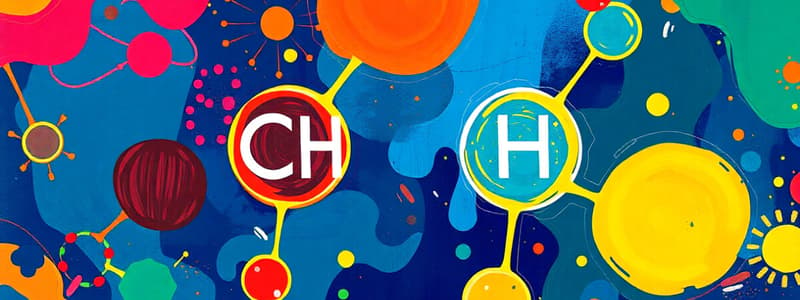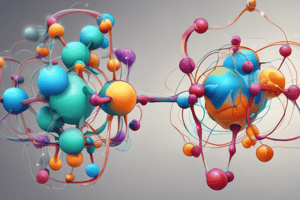Podcast
Questions and Answers
What type of hybridization involves the combination of one s orbital and two p orbitals?
What type of hybridization involves the combination of one s orbital and two p orbitals?
- sp3 hybridization
- sp2 hybridization (correct)
- dp hybridization
- sp hybridization
Which molecular geometry corresponds to sp hybridization?
Which molecular geometry corresponds to sp hybridization?
- Octahedral
- Tetrahedral
- Linear (correct)
- Trigonal Planar
Which of the following statements about sigma (σ) bonds is true?
Which of the following statements about sigma (σ) bonds is true?
- Sigma bonds are formed by sideways overlapping of p orbitals.
- Sigma bonds result from head-on overlapping of hybrid orbitals. (correct)
- Sigma bonds involve only the s orbitals.
- Sigma bonds are weaker than pi (π) bonds.
How does hybridization aid in understanding molecular geometry?
How does hybridization aid in understanding molecular geometry?
What type of hybridization is associated with a tetrahedral molecular shape?
What type of hybridization is associated with a tetrahedral molecular shape?
What is the effect of hybridization on a molecule's properties?
What is the effect of hybridization on a molecule's properties?
Which hybridization type results from combining one s orbital and three p orbitals?
Which hybridization type results from combining one s orbital and three p orbitals?
Which of the following describes the nature of pi (π) bonds?
Which of the following describes the nature of pi (π) bonds?
Flashcards
What is chemical bonding?
What is chemical bonding?
The process of atoms joining together to create molecules or compounds. Driven by the need to achieve a stable electron configuration.
What are ionic bonds?
What are ionic bonds?
A type of chemical bond formed by the transfer of electrons between atoms, usually between a metal and a nonmetal.
What are covalent bonds?
What are covalent bonds?
A type of chemical bond formed by the sharing of electrons between atoms, usually between nonmetals.
What are metallic bonds?
What are metallic bonds?
Signup and view all the flashcards
What is hybridization?
What is hybridization?
Signup and view all the flashcards
What is sp hybridization?
What is sp hybridization?
Signup and view all the flashcards
What is sp2 hybridization?
What is sp2 hybridization?
Signup and view all the flashcards
What is sp3 hybridization?
What is sp3 hybridization?
Signup and view all the flashcards
Study Notes
Chemical Bonding
- Chemical bonding is the joining of two or more atoms to form molecules or compounds. This joining is driven by the tendency of atoms to achieve a stable electron configuration, often a full outermost electron shell.
- Types of chemical bonds include ionic bonds, formed by the transfer of electrons between atoms; covalent bonds, formed by the sharing of electrons between atoms; and metallic bonds, formed by the sharing of delocalized electrons in a sea of electrons surrounding positively charged ions.
- Ionic bonds typically form between metals and nonmetals, where the metal loses electrons and the nonmetal gains electrons.
- Covalent bonds typically form between nonmetals, where atoms share electrons to achieve a stable configuration.
- Metallic bonds are characteristic of metals, where valence electrons are delocalized and shared among many atoms.
- Properties of substances are influenced by the type of bonding. For example, ionic compounds generally form crystalline solids with high melting points, while covalent compounds can be gases or liquids at room temperature.
Hybridization
- Hybridization is a concept in chemistry that helps explain the shapes of molecules. It describes the mixing of atomic orbitals to form new, hybrid orbitals that are used in bonding.
- Hybridization is a theoretical model that aids in understanding the complex molecular geometry.
- The types of hybridization are determined by counting the number of bonding groups (single, double, or triple bonds) and lone pairs around the central atom.
- Common types of hybridization include sp, sp2, and sp3, which correspond to different molecular geometries like linear, trigonal planar, and tetrahedral, respectively.
- sp hybridization involves the combination of one s orbital and one p orbital.
- sp2 hybridization involves the combination of one s orbital and two p orbitals.
- sp3 hybridization involves the combination of one s orbital and three p orbitals.
- Sigma (σ) bonds are formed by the head-on overlapping of hybrid orbitals.
- Pi (π) bonds are formed by sideways overlapping of p orbitals and are weaker than sigma bonds. They result from the unhybridized p orbitals.
- Different types of hybridization result in different molecular shapes. The resulting molecular shapes influence the molecule's reactivity and properties.
- The concept of hybridization is crucial for predicting the shapes and bonding characteristics of molecules, especially those involving carbon.
Studying That Suits You
Use AI to generate personalized quizzes and flashcards to suit your learning preferences.




